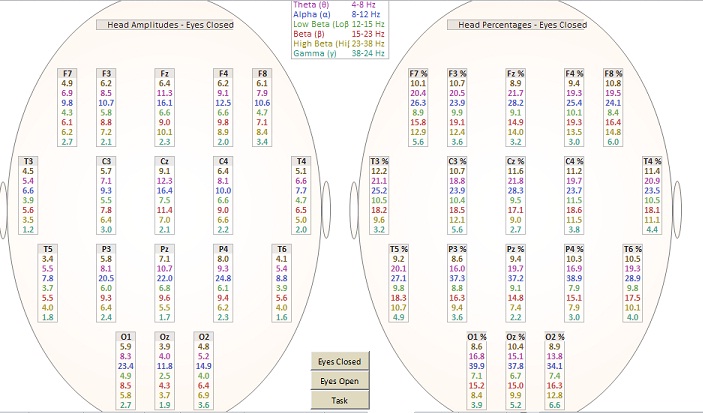Brain Wave Fundamentals
Biofeedback for the brain, to address a host of neurological ills.
Brain waves are the result of the activity of brain cells. Brain cells, or Neurons, communicate with other Neurons by chemical and electrical activity. The constant electrical changes in Neuronal functioning can be seen as waves as represented in the EEG (Electroencephalogram). Brain waves are measured in cycles per second, or Herz (i.e., ‘brain wave frequency’).
Higher frequencies are associated with faster brain activity, or arousal. Conventionally, brain wave frequencies have been categorized into four primary types, or band-widths:
- Delta waves – from 0- 4 Hz., occurring predominantly during sleep
- Theta waves – from 4 – 7 Hz., found in states of deep relaxation, hypnosis and visualization
 Want to overcome Anxiety related situations … NeuroFeedback has an APP for that…
Want to overcome Anxiety related situations … NeuroFeedback has an APP for that…
Call or Text us for an Introductory NeuroFeedback Session in Our Kitsilano, Vancouver, BC Location – and Eliminate Your Anxiety This Year. 604-785-1709 www.no-stress-success.com
- Alpha waves – from 8 –13 Hz., seen in states of calmness and daydreaming. Alpha is also the ‘parking’ state of the brain, when not engaged in activity
- Beta waves – from 13 – 38 Hz., which is often broken down into a number of narrower bands, each having particular behavioral qualities – occurring during active thought and problem solving, and at the higher frequencies, tension, anxiety, obsessive thinking and compulsive behavior
- SMR waves – a narrow frequency band within the Beta range (12 – 15 Hz.), associated with relaxed, focused attention
- Mid Beta – (16 –25 Hz.) – associated with problem solving, like math problems, puzzles, and at the higher end of this range, anxious feelings
- High Beta – (over 26 Hz.) – often found with
 high anxiety and excessive obsessive thinking
high anxiety and excessive obsessive thinking
What are the Causes of Brainwave Dysregulation
The brain may begin to malfunction for many different reasons, ranging from genetic abnormalities, chronic stress or illness, emotional stress or illness, biochemical damage due to substance abuse, and sometimes from medications.
Pharmaceutical agents (medications) are often prescribed to manage the various symptoms associated with brain dysregulation, ranging from attention deficits, anxiety, depression, insomnia, Tourette’s Syndrome, to name just a few. However, medications typically do not treat the root cause of the problem and are often associated with negative side effects.
Neurofeedback is a safe, non-invasive treatment that directly addresses brain dysregulation and assists the individual to restore balanced brain functioning.
Research has shown that many kinds of psychological difficulty are associated with problems in activation in various areas of the brain. Patterns of underactivation, over-activation, or disturbed coordination of brain activity have been found with many kinds of symptoms in brain imaging studies. This is true of attention deficits, anxiety, depression and other mood problems, autism spectrum disorders, tics, and learning disabilities.
The electroencephalograph (EEG) is a way to show and measure brain activation. The EEG shows momentary increases and decreases in activity only milliseconds after they occur in the brain area being monitored. Over twenty years ago, neuroscientists discovered that we are able to alter these patterns of activation in the brain if we can see the momentary changes the instant they occur. This prrocess is called biofeedback – getting immediate information about our biological processes.
Many years of experience in clinics all over the world and numerous scientific studies have shown that this process of EEG biofeedback is an effective means to improve, even normalize, attention in individuals with ADHD, to elevate mood in those with depression, to facilitate recovery in those with addictions, to relieve anxiety, improve cognitive function, and to decrease seziures.
Frank Duffy, MD, Neurologist, Head of the Neuroimaging Department and of Neuroimaging Research at Boston Children’s Hospital, and Harvard Medical School Professor, conducted an independent review of the literature on neurofeedback for Clinical Electroencephalography (2000). He summarized his findings as follows:
“The literature, which lacks any negative study of substance, suggests that EEG biofeedback therapy should play a major therapeutic role in many difficult areas. In my opinion, if any medication had demonstrated such a wide spectrum of efficacy, it would be universally accepted and widely used. “
In a recent paper Update on attention-deficit/hyperactivity disorder published in Current Opinion in Pediatrics Katie Campbell Daley reviewed the research and practice standards on treatment of ADHD. Dr. Campbell serves on the staff of the Department of Medicine, Children’s Hospital Boston and in the Department of Pediatrics of the Harvard Medical School. She concluded:
“Overall, these findings support the use of multi-modal treatment, including medication, parent/school counseling, and EEG biofeedback, in the long term management of ADHD, with EEG biofeedback in particular providing a sustained effect even without stimulant treatment…parents interested in non-psychopharmacologic treatment can pursue the use of complementary and alternative therapy. The therapy most promising by recent clinical trials appears to be EEG biofeedback.”
A recent special issue of Child and Adolescent Psychiatric Clinics of North America was devoted to emerging interventions that affect brain function. Neurofeedback was featured in seven of the ten chapters in the volume. The volume editors provided an overview and clinical perspective on all the approaches presented. About neurofeedback they concluded:
“EEG biofeedback meets the American Academy of Child and Adolescent Psychiatry criteria for clinical guideline (CG) for treatment of ADHD, seizure disorders, anxiety (OCD, GAD, PTSD, phobias), depression, reading disabilities, and addictive disorders. This suggests that EEG biofeedback should always be considered as an intervention for these disorders by the clinician.”


